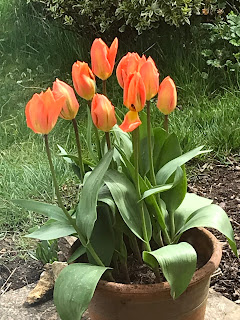A few dry days – at last – over the past weekend allowed us to get on with jobs in the garden, especially the first cut of the lawn. The cowslips are in full flower so that area was left uncut, and the grass around the plum tree was also left to allow the orchids to flower later in the year; but the garden always looks tidier with the main part of the grass mown.
Ahead of the mowing, I dug into the pile of old grass
clippings (not dealt with for about three years, I think) and moved some of it
under the apple cordons, to help keep the weeds down. I’m slowly working my way along the row,
removing weeds and grass as I go, and pondering what to do about the soil in
front of the cordons. I’ve hit upon a
solution, which may or may not be a wise move.
There are a lot of self-seeded oregano plants in the garden, especially in the old
herb bed where I’m planning to plant out the dahlias this year; I’ve been
reluctant to get rid of the oregano as it’s pretty in flower, and useful in the
kitchen, but moreover it attracts huge numbers of butterflies and bees in
summer, which are very welcome. So I’ve
started moving some of it to the apple bed, which is in full sun and ought to suit. Am I creating another problem for
myself, with the oregano taking over under the apples? I’ll need to be ruthless about cutting it
back, even though the seedheads attract goldfinches in winter; I won’t be able
to allow it to seed, and I think I’ll have to renew it periodically to stop it
becoming too woody. We’ll see.
I also found a couple of bags of old leaf mould and rotted
sawdust, and spread them on some of the veg beds. The birds enjoyed this; there were
blackbirds, a thrush, goldfinches and a wren picking over the area once I moved
away. There is a lot of nesting activity
at the moment; the sparrows are collecting grass, and the thrush has been
picking up mud from the pond for her nest.
 |
| Tulips 'Dreamer' - and 'National Velvet' ('Havran' in bud in front) |
The tulip pots are continuing to brighten up even the dull days. The ‘Dreamer’ pot is developing nicely, and, despite what I said in my last post, the dark pointed tulips are in fact ‘National Velvet’; ‘Havran’ is not yet in flower, just in bud. In the biggest pot, ‘Prinses Irene’ is starting to come out, with the much taller ‘Black Hero’ and shorter ‘Uncle Tom’ still to come. The first of the ‘Doll’s Minuet’ is out, and the more I see of this tulip the more I like it; the colour is glorious, and the petals twist outwards in a very elegant way. I’m thinking that it might work as a partner for ‘Prinses Irene’ in a future planting, perhaps with a dark tulip to provide contrast, and to damp down the colour clash; while orange and pink is a combo that I would normally back away from in horror, the darker markings on the backs of both tulips combine well, and the effect would be – how should I put this? – striking. Shocking, even - but certainly colourful!
 |
| Tulip 'Doll's Minuet' |
 |
| Tulip 'Prinses Irene' |
After the dry weekend, the weather has turned showery and windy again, and quite chilly. In fact we’ve just had a brief snow shower …














